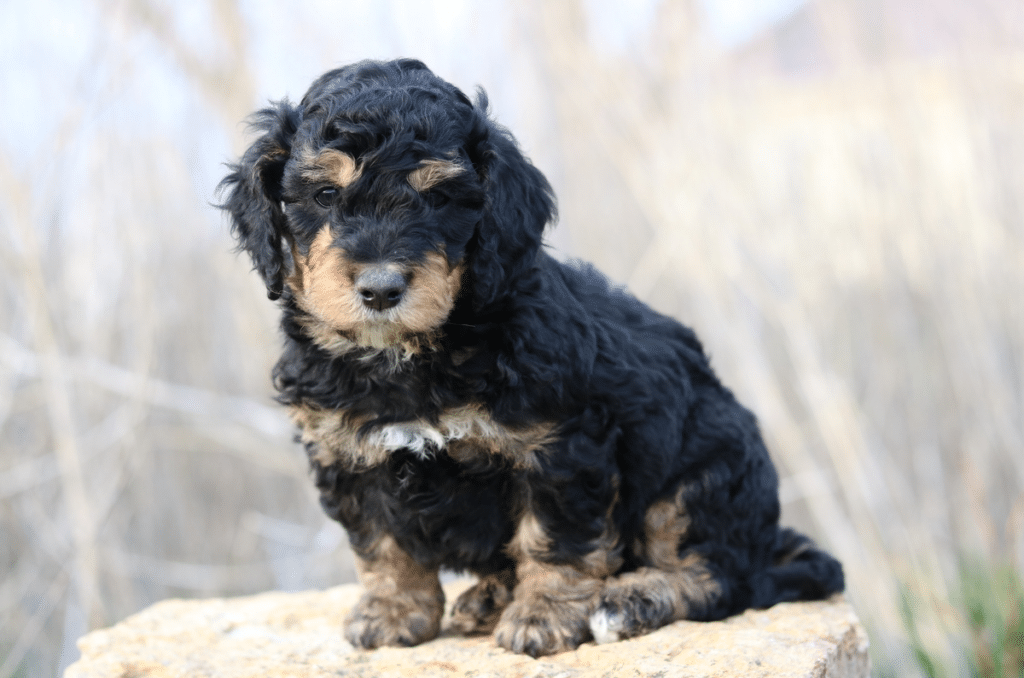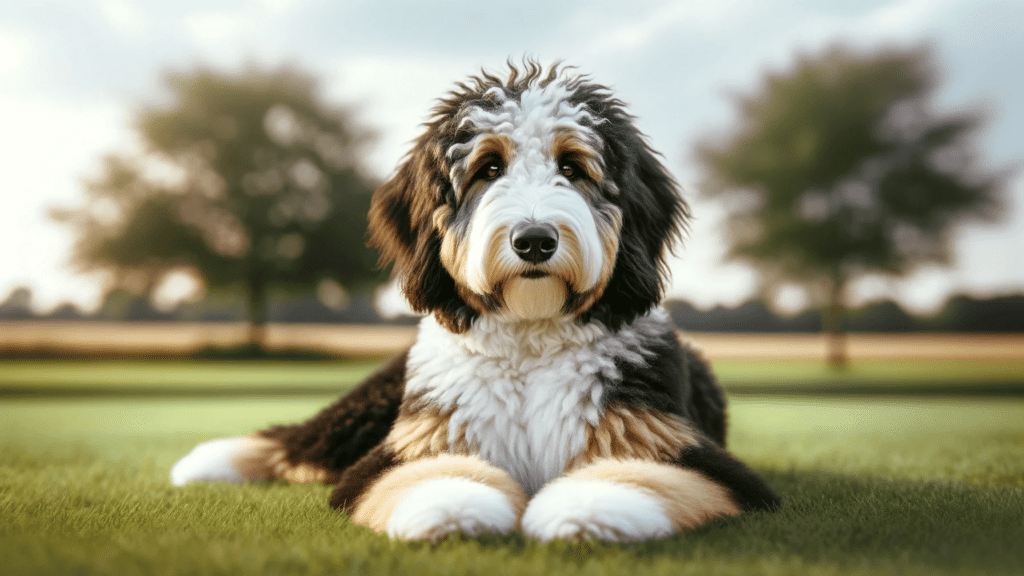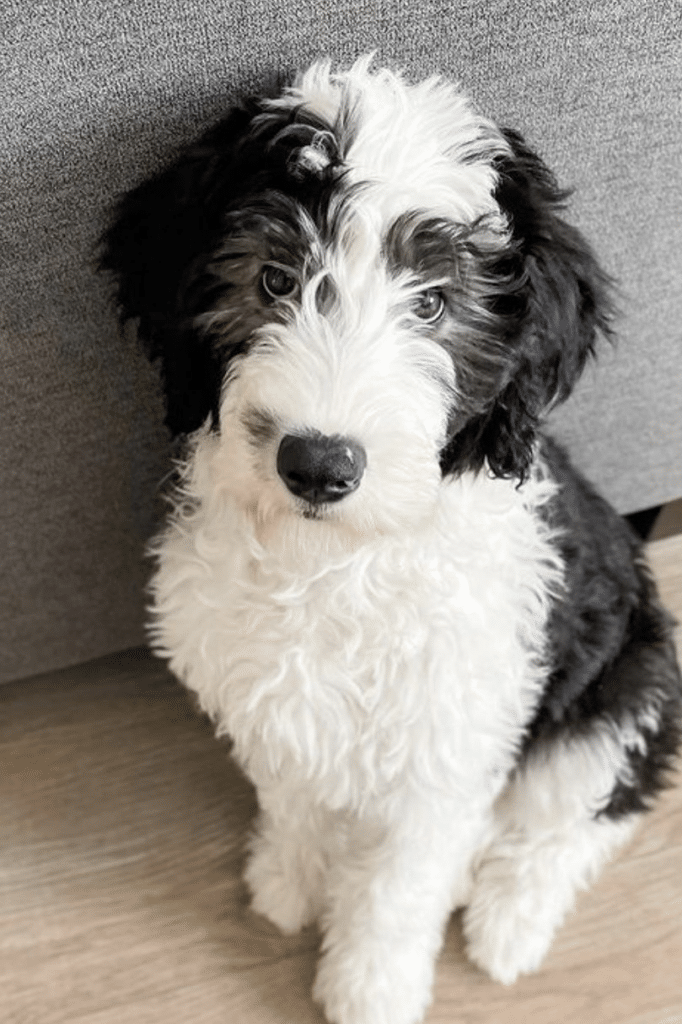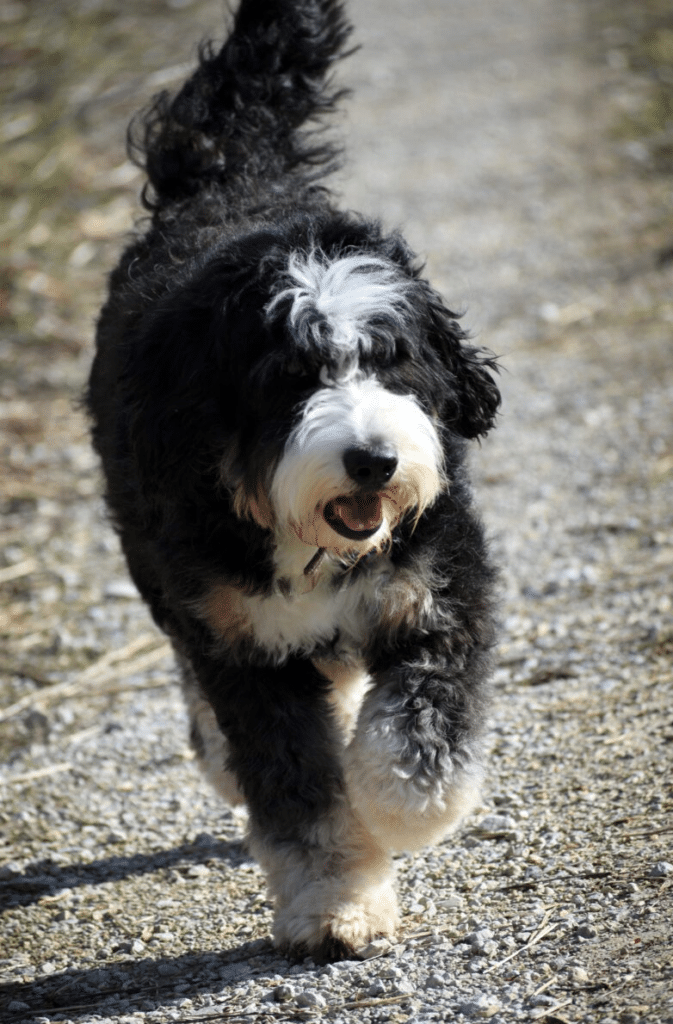Last Updated on May 23, 2024 by Amin Tawar
To understand what an F1B Bernedoodle is, it’s important to understand a variety of things first. What is a Bernedoodle in the first place? If it’s a cross breed between a Bernese Mountain Dog and a Poodle (as the name makes it sound), then what does ‘F1B’ mean? What are the characteristics of this dog and why are they bred? What do dog generations look like? Let’s dive right in.
What Exactly Is a F1B Bernedoodle?

An F1B Bernedoodle is indeed a cross breed created by mixing the Bernese Mountain Dog and the Poodle. However, it’s not a fifty fity split between the two breeds. This kind of Bernedoodle is further removed from its Bernese Mountain Shepherd ancestor, making it a second generation cross breed. Poodle mixes, often called doodles, are bred this way especially to make their coats more hypoallergenic.
Thus, an F1B Bernedoodle is more Poodle than Bernese Mountain Dog while still retaining the desirable qualities and traits from either breed.
What Are the Generations in Dog Breeding?
Any kind of dog breeding (or animal breeding in general) has different generations. Breeders don’t always just breed one purebred dog with another. They mix it up from time to time and look for ways to make different breeds healthier or easier to care for. These generations are given different names, such as F1 or F1B.
Let’s start with the very first generation which is P. This is a completely purebred dog which adheres to standards set by kennel clubs around the world and is registered by them as a purebred dog. Then, there is the F1 generation. The F1 generation is when one purebred dog of a certain breed is mated with another purebred dog of another breed. It produces puppies that are split fifty fifty. Thus, they have exactly half the genes from either parent.
An F1B, on the other hand, is what is called a backcross. This means that the breeder cross breeds an F1 dog with a purebred dog from either one of the parent generations. Thus, the resulting litters have seventy five percent DNA from one breed and only twenty five percent from the other. This happens a lot with Poodle mixes since breeders often want the Poodle genes to dominate. F1BB (an F1B dog crossed with a purebred dog) is also possible, which contains even more of a disparate split.
F2 dogs are dogs that are bred from two F1 dogs of the same kind. For example, if an F1 Labradoodle was bred with an F1 Labradoodle, they would both produce an F2 Labradoodle. This dog would again have a fifty fifty split in its genes but in a different way than the F1 generation. Then. F2B is when an F1 dog is crossed with an F1B dog. And so on and so forth.
Dog breeding is serious business and reputable breeders undertake a lot of research and study before they go about creating new generations.
F1, F1B, F2 and F2B Bernedoodle Dogs and Their Differences

An F1 Bernedoodle, as explained above, is created when a purebred Poodle is crossed with a purebred Bernese Mountain Dog. This results in a dog that is fifty percent Poodle and fifty percent Bernese Mountain Dog. Bigger in size than many other doodles, the F1 Bernedoodle comes in standard and mini sizes.
They’re traditionally tricolored, like their Bernese parents, and have thick, wavy coats. These coats are mildly hypoallergenic and shed very lightly, which makes them suitable for people with mild allergies. The curlier the coat, the less it sheds.
The F1B Bernedoodle is a cross breed from an F1 Bernedoodle and a purebred Poodle. These dogs are essentially seventy five percent Poodle and just twenty five percent Bernese Mountain Dog. With beautiful wavy or curly coats, they’re one of the most hypoallergenic of all Bernedoodles. They barely shed at all.
Despite their high Poodle concentration, they don’t look like Poodles at all. In fact, the Bernese looks are quite dominant, other than the coat. They come in three sizes – standard, mini and tiny (a category that F1 Bernedoodles don’t have).
F2 Bernedoodles are created by breeding two F1 parents together. They’re pretty unpredictable and their coats can go one way or the other, from the straight long highly shedding coat of the Bernese to the curly hypoallergenic coat of the Poodle. They’re not really recommended by breeders because of their unpredictability.
The F2B generation, often called the teddy bear Bernedoodle, comes from an F1 Bernedoodle crossed with an F1B Bernedoodle. A lot of families prefer them because of their higher ratio of Bernese Mountain Dog blood as compared to the F1B generation.
The Bernese Mountain Dog Ancestor
Now that we’ve discussed generations, it’s also important to take a look at the parent breeds. New designer breeds like the Bernedoodle aren’t firmly established enough for us to have an accurate measure of their temperament and behavior. Looking at the parent breeds answers some of these questions since hybrids are created precisely because breeders want to retain the desirable qualities.
Sweet and loyal, the Bernese Mountain Dog originated in the Swiss Alps and in Bern, Switzerland. They were hard-working farm dogs and were also used to pull carts and heavy loads because of their immense size. With a long, straight coat and a specific tricolor pattern, these dogs are handsome as well as good natured.
Self-assured, placid and docile by nature, these dogs love the outdoors and need a lot of activity and exercise. While they can move with startling bursts of speed, given their large size, they don’t have a lot of endurance. They do well with hiking and walking and are very well-behaved around children. In fact, a Bernese will patiently allow small kids to climb all over them.
The Poodle Ancestor
The Poodle, on the other hand, was bred to be a water retriever and hunter. With an extremely energetic nature and very sharp mind, the Poodle originated in Germany but was popularized in France. It comes in three sizes – standard, miniature and toy – and has a very distinctive thick, curly coat.
Poodles eventually evolved to become circus dogs and show dogs because of their high intelligence and stellar good looks. They’re one of the most popular breeds in the entire world, doubly so since their thick coats don’t shed much (unlike other popular breeds like Labrador Retrievers, German Shepherds and Golden Retrievers).
They’re a very sociable breed and do very well in obedience training and agility. They learn best by positive reinforcement and are considered the second most intelligent working breed, right after the Border Collie. They’re usually kept as companion dogs in the modern day although they make excellent service dogs.
History of the Bernedoodle
Thus, the Bernedoodle was created to have some of the best aspects of the Poodle and the Bernese Mountain Dog. The Bernedoodle is recent even by doodle standards, only having been created in 2003. The objective was to create an intelligent and hypoallergenic breed with the calm, loyal temperament of the Bernese Mountain Dog.
In recent years, they have become very popular indeed. With the appearance of social media, Bernedoodles have become stars whose lives are followed by millions of people worldwide.
F1B Bernedoodle Size and Appearance

F1B Bernedoodles are smaller in size than F1 Bernedoodles. But there are variations, depending on what type of Poodle they are descended from. Size and appearance variations are common in doodles and there is no predicting what your puppy will look like as an adult when you first bring it home.
F1B Bernedoodles officially come in three sizes. The Tiny ones weigh about 15 to 30 lb (6.8 – 13.6 kg) while the Miniature ones weigh around 35 to 50 lb (15.8 – 22.6 kg). The biggest are the Standards, which can weigh anywhere between 50 and 90 lb (22.6 – 40.8 kg). They can vary in height from 12 inches all the way to 29 inches.
The thick coats of the F1B Bernedoodle more closely resemble the coat of the Poodle than of the Bernese Mountain Dog. Curly or wavy, they don’t shed much but do need quite a lot of grooming. The most popular coloring is the tricolor Bernedoodle (black, white and tan) like their Bernese lines. However, F1B Bernedoodles do sometimes inherit the solid coat of a Poodle.
They have flatter faces than the Poodle does and have long, droopy ears. Altogether, they’re handsome dogs with a personality to match.
F1B Bernedoodle Behavior and Temperament
Overall, the Bernedoodle has a calm, loyal and highly trainable personality. Basically, it’s the best of both worlds from the Poodle and Bernese Mountain Dog breeds. These dogs can be somewhat wary of strangers but they are absolutely devoted to their family. They’re goofy and intelligent at the same time and tend to win hearts wherever they go.
Having said that, there’s no knowing what personality traits an F1B Bernedoodle will inherit exactly. Temperament can differ from dog to dog even within a single breed. And when you take hybrids into account, it’s quite unpredictable. It’s unlikely that your Bernedoodle will be aggressive, however, even if they inherit the sometimes stubborn personality of the Bernese.
They can be trained with positive reinforcement and socialization should start from a young age, especially if they’re apprehensive around strangers. Their intelligence means that they can pick up commands quickly. They’re high energy dogs and enjoy a lot of exercise. Thus, daily walks and playtime are a must.
F1B Bernedoodle Health
Like most cross breeds, Bernedoodles are generally healthy dogs. However, some issues crop up in this breed. Thus, it’s important to monitor your dog’s health regularly and make sure that no health problems crop up. Schedule regular check-ups with your vet.
As with many dog breeds, one of the biggest concerns with Bernedoodles is hip and elbow dysplasia. This is genetic and responsible breeders can work to cull it from the breed. But it is a painful disorder that can cause your dogs a lot of discomfort and lead to arthritis in old age. Bloat, progressive retinal atrophy leading to blindness and hereditary cataracts are other issues. Cancer and hypothyroidism is something Bernese Mountain Dogs are vulnerable to and this can be passed down.
It’s important to feed your dog a balanced diet, exercise them properly and groom them regularly. While some diseases are genetic, these actions on your part can help.
F1B Bernedoodle Exercise and Grooming Needs
The grooming needs of an F1B Bernedoodle are more than moderate. Their curly fur is prone to matting and tangling unless regularly brushed. Indeed, you wouldn’t go wrong with daily grooming sessions for your doodle. These help build bonds between dogs and owners and can even prevent skin allergies.
Trimming their nails and cleaning their ears every two weeks is a must. If you’re nervous about grooming your Bernedoodle, there are a number of reputed salons that offer such services. Clean their teeth on a daily basis with dog-safe toothpaste.
Bernedoodles are high energy dogs and need lots of exercise. You should take them for a walk every day and indulge them with lots of play time. As this breed tends towards obesity, keeping their weight in check is of utmost importance. Most Bernedoodles love games of fetch and they can be trained for dog sports like agility and flyball as well. Because of their Bernese genes they’re good hikers and their Poodle genes make them good swimmers.
Conclusion
And that’s all that you need to know about the F1B Bernedoodle. I hope that this article was helpful and that you gained something valuable from it.
